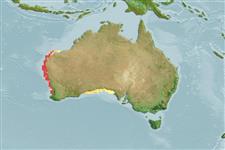>
Blenniiformes (Blennies) >
Blenniidae (Combtooth blennies) > Salariinae
Etymology: Cirripectes: Latin, cirrus = curl fringe + Greek, pektos, -e, -on = made of several parts solidly united (Ref. 45335); hutchinsi: Named for Barry Hutchins of the Western Australian Museum..
Environment: milieu / climate zone / depth range / distribution range
นิเวศวิทยา
เกี่ยวกับทะเล,น้ำเค็ม เกี่ยวกับหินโสโครก; ระดับความลึก 1 - 22 m (Ref. 529). Subtropical; 20°S - 33°S
Eastern Indian Ocean: known only from Western Australia (North West Cape southward to Rottnest Island).
Length at first maturity / ขนาด / น้ำหนัก / Age
Maturity: Lm ?, range 7 - ? cm
Max length : 10.6 cm SL เพศผู้/กระเทย; (Ref. 529)
Short description
สัณฐานวิทยา | ความยาวต่างๆ
เงี่ยงครีบหลัง (รวม): 12 - 13; ก้านครีบอ่อนที่หาง (รวม): 13-14; เงี่ยงครีบก้น 2; ก้านครีบอ่อนที่ก้น: 15 - 16; สัตว์มีกระดูกสันหลัง: 30 - 31. Diagnosis: Dorsal fin XII, 14, membrane attached to caudal fin, with deep notch above last spine, first spine almost same or slightly higher than second; anal fin II, 15; pectoral rays 15; pelvic fin I, 4; caudal fin procurrent rays 11-14. Vertebrae 10 + 20-21. LL, without scales and scalelike flaps; LL tubes 3-9 (usually 8-13), canal ends below posterior to 13h dorsal ray, usually on caudal-fin base. Upper lip crenulae 36-42. Gill rakers 23-29. Cephalic sensory pore system complex. Cirri, nuchal 35-42, nasal 8-93, supraorbital 12-29; 4 groups of nuchal cirri, each ventralmost group borne on slightly expanded nuchal flap. No pores at extra interorbital pore position. Geographic variation in color pattern exists in females; 2 color patterns in male may exist in the same geographic area; background color brown; yellow to orange iris (Ref. 529).
Facultative air-breathing in the genus (Ref. 126274); Found in the surge zone in limestone holes just below the intertidal range. Common in areas where Pocillopora damicornis is present on the reefs (Ref. 529). Oviparous. Eggs are demersal and adhesive (Ref. 205), and are attached to the substrate via a filamentous, adhesive pad or pedestal (Ref. 94114). Larvae are planktonic, often found in shallow, coastal waters (Ref. 94114).
Oviparous, distinct pairing (Ref. 205). Urogenital orifice of male genital papilla located basally between 2 widely separated slender filaments on a fleshy swelling behind anus; testes bulbous with length equal to its width (Ref. 529).
Williams, J.T., 1988. Revision and phylogenetic relationships of the blenniid fish genus Cirripectes. Indo-Pac. Fish. (17):78 p. (Ref. 529)
IUCN Red List Status (Ref. 130435)
Threat to humans
Harmless
Human uses
การประมง: ไม่มีผลประโยชน์
ข้อมูลเพิ่มเติม
Age/SizeการเจริญเติบโตLength-weightLength-lengthLength-frequenciesความยาวต่างๆสัณฐานวิทยาตัวอ่อนพลวัตของสัตว์น้ำวัยอ่อนการทดแทนที่อุดมสมบรูณ์BRUVS
อ้างอิงการเพาะเลี้ยงสัตว์น้ำประวัติการเพาะเลี้ยงสัตว์น้ำสายพันธุ์พันธุศาสตร์ElectrophoresesอัตราพันธุกรรมโรคการแปรรูปNutrientsMass conversion
ผู้ร่วมมือรูปภาพหลายรูปStamps, Coins Misc.เสียงปลามีพิษ เช่น ปลาปักเป้าความเร็วรูปแบบการว่ายน้ำพื้นที่เหงือกOtolithsสมองวิสัยทัศน์
เครื่องมือ
Special reports
Download XML
แหล่งที่มาจากอินเตอร์เน็ต
Estimates based on models
Preferred temperature (Ref.
123201): 18.1 - 26.7, mean 22.2 °C (based on 115 cells).
Phylogenetic diversity index (Ref.
82804): PD
50 = 0.5000 [Uniqueness, from 0.5 = low to 2.0 = high].
Bayesian length-weight: a=0.01072 (0.00480 - 0.02393), b=3.01 (2.82 - 3.20), in cm total length, based on LWR estimates for this (Sub)family-body shape (Ref.
93245).
ระดับชั้นอาหาร (Ref.
69278): 2.0 ±0.00 se; based on food items.
ความสามารถในการกลับคืนสู่ปกติ (Ref.
120179): ความสูง, เวลาต่ำสุดที่จะทำให้ประชากรเพิ่มขึ้นเป็น 2 เท่าใช้เวลาน้อยกว่า 15 เดือน (Preliminary K or Fecundity.).
Fishing Vulnerability (Ref.
59153): Low vulnerability (10 of 100).
Nutrients (Ref.
124155): Calcium = 79.9 [29.7, 158.9] mg/100g; Iron = 0.851 [0.471, 1.527] mg/100g; Protein = 19 [18, 20] %; Omega3 = 0.202 [0.108, 0.368] g/100g; Selenium = 10.3 [4.7, 23.1] μg/100g; VitaminA = 75.6 [20.1, 285.3] μg/100g; Zinc = 1.67 [1.04, 2.65] mg/100g (wet weight);
